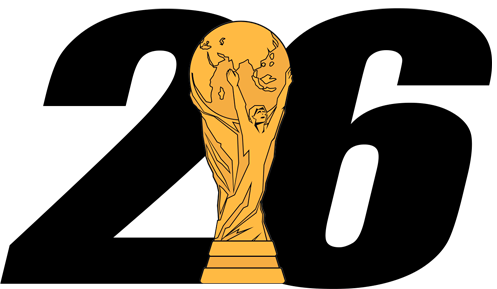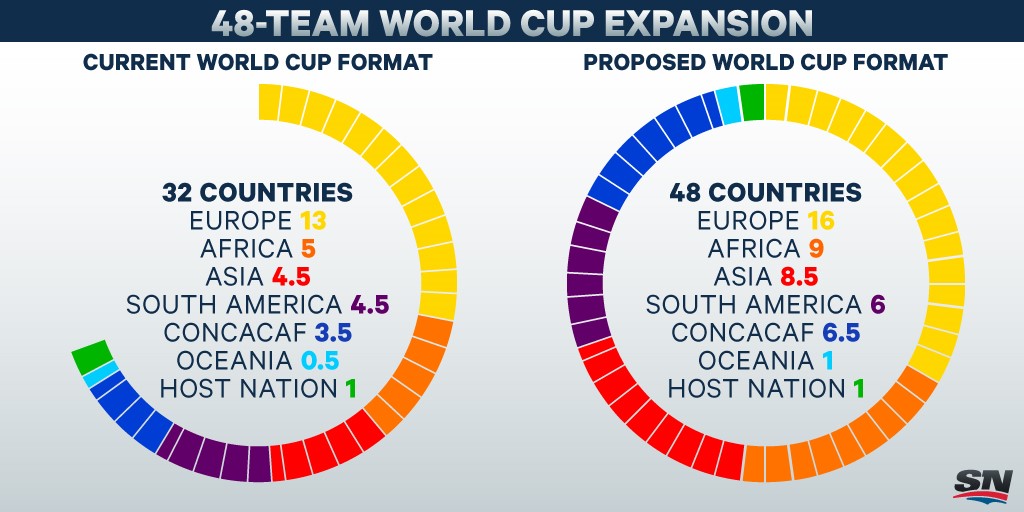The World Cup in Qatar 2022 concluded in December, leaving football fans worldwide in eager anticipation for the next grand event.
This next spectacle, however, is not only awaited for the extraordinary football action but also for the transformation it brings to the tournament’s format.
The World Cup of 2026 promises to be a landmark event, featuring 48 participating teams and matches spread across three North American countries – the United States, Mexico, and Canada.
A Tri-Nation Spectacle

For the first time, the World Cup will span three host nations. The US will be the primary organizer, contributing the majority of venues, followed by Canada and Mexico.
Canada will host its first World Cup, the United States its second, and Mexico its third, becoming the first country to host the World Cup thrice.
North America’s bid for hosting prevailed over Morocco’s, finalizing on June 13, 2018, at FIFA’s Congress in Moscow, Russia.
World Cup 2026 Format and Schedule
Unlike its predecessor in Qatar, the 2026 World Cup will take place in summer, from June 8 to July 19, featuring 104 matches over 40 days—40 games more than previous editions.
Despite the increase, FIFA maintains that the revised format ensures balanced rest times and a minimum of three matches for every team. The tournament will consist of 12 groups of four teams, a shift from the preceding 32-team format established since 1998.
World Cup 2026 Group Configurations and Qualifications
The discussions around the grouping have been intricate, sparking debates among players, federations, and fans. Initially, FIFA contemplated 16 groups of three teams, with the top two advancing to a 32-team knockout stage.
But, this format, necessitating 80 matches, would burden unified schedules and trivialize some matches. Reflecting on the vibrant group phase in Qatar, FIFA decided to maintain groups of four, distributed across 12 instead of the usual eight groups.
This implies an additional round of 16, with matchups determined by a draw based on first-round rankings. The top eight teams would face one of the eight best third-placers, while the remaining four leaders would face one of the twelve second-placed teams.
With this new format, FIFA had to increase the allocation of spots to each confederation, introducing several novelties to the global qualifying phases.
Europe, with 16 direct representatives, remains the continent with the most representatives, but with only three more spots than in 2022 and no access to inter-confederation playoffs.
World Cup 2026 Confederation Allocations
Conmebol will have 6.5 spots, an increase from 4.5, while Concacaf, including the three host nations, will have six fixed representatives and a chance for one more via inter-confederation playoffs.
Asia will see an increase from 4.5 to 8.5 spots, Oceania will have one fixed representative plus a chance in the playoffs, and Africa will have nine fixed spots, plus one in the playoffs, potentially bringing ten African nations to the World Cup.
World Cup 2026 The Venues

The US will dominate the venue list, with only Vancouver and Toronto representing Canada, and Monterrey, Guadalajara, and Mexico City representing Mexico. Among the US cities, only five that hosted the 1994 World Cup will repeat, with the others being Seattle, Kansas City, Atlanta, Houston, Philadelphia, and Miami, and Los Angeles likely hosting the final on July 19.
Conclusion
The expansion to 48 teams brings both excitement and skepticism. FIFA stands to gain significantly, prolonging the world’s greatest event and boosting ticket sales and broadcasting rights.
Smaller nations with typically lower chances of qualification also benefit, enabling countries like Venezuela, Guatemala, and Kosovo to realistically dream of World Cup participation. However, this expansion raises concerns about diluting the quality of competition and diminishing the excitement of qualifying rounds.
Many argue that the increased participation could lower the World Cup’s overall quality, as we’ve moved from a 24-team World Cup to one featuring double the countries in just over 30 years.
However, others appreciate the inclusion, as it allows newer nations to experience the grandeur of the World Cup and reduces disparities in international football.
The anticipation surrounding this revolutionary World Cup is palpable, and as fans worldwide engage in debates and discussions, it’s evident that this global festival of football in 2026 holds promises of unprecedented excitement and a touch of the unknown.





You helped me a lot with this post. I love the subject and I hope you continue to write excellent articles like this.
Please provide me with more details on the topic
Your post is not only informative but also beautifully written. Keep up the great work! Watch Noir Movies Online
Your articles are extremely helpful to me. May I ask for more information?